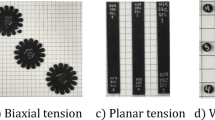Abstract
The stress-strain relationships of a rubber material in uniaxial tension, equi-biaxial tension and plane shear loading conditions are tested here. Constitutive parameters in different constitutive models, such as Mooney-Rivlin model, Van Der Waals model and Marlow model can be obtained by least square method using measured and calculated stress-strain relations. The rubber isolators in two rubber mounts are investigated here. Rubber mount I bears stretching/compression deformation or shear deformation, while mount II bears both deformations simultaneously. Using obtained constitutive constants, the rubber isolators’ static stiffness values in three mutually perpendicular directions are calculated, analyzed and compared with their measured results. Based on Mooney-Rivlin model, the effects of these constitutive constants on static stiffness of the two mounts are discussed by comparison. The effects of different models on static force-displacement characteristics of rubber mount I are also analyzed. The conclusion is that it is necessary to choose a relatively accurate constitutive model and appropriate methods for obtaining the model constants in describing rubber characteristic.
Similar content being viewed by others
References
Seibert, D. J. and Schöche, N., “Direct comparison of some recent rubber elasticity models,” Rubber Chemistry and Technology, Vol. 73, No. 2, pp. 366–384, 2000.
Jianlong, H., Guangjuan, X., and Zhengwei, L., “Finite element analysis of super-elastic rubber materials based on the mooney-rivlin and yeoh model,” China Rubber/Plastics Technology and Equipmrnt, Vol. 34, No. 12, pp. 21–26, 2008.
Wang, L. R. and Lu, Z. H., “Modeling methods of constitutive law of rubber hyperelasticity based on finite element simulations,” Rubber Chemistry and Technology, Vol. 76, No. 1, pp. 271–285, 2003.
Gracia, L. A., Liarte, E., Pelegay, J. L., and Calvo, B., “Finite element simulation of the hysteretic behavior of an industrial rubber. Application to design of rubber components,” Finite Elements in Analysis and Design, Vol. 46, No. 4, pp. 357–368, 2010.
Hartmann, S., Tschöpe, T., Schreiber, L., and Haupt, P., “Finite deformations of a carbon black-filled rubber. Experiment, optical measurement and material parameter identification using finite elements,” European Journal of Mechanics — A/Solids, Vol. 22, No. 3, pp. 309–324, 2003.
Guo, Z. H., “Nonlinear Elasticity Theory,” Beijing: Science Press, 1980.
Cui, Z. Q., “Metallography & Heat Treatment [M],” Beijing: Machinery Industry Publication, 2001.
ABAQUS, Inc. “ABAQUS Analysis User’s Manual,” 2006.
Yeoh, O. H., “On the Ogden strain-energy function,” Rubber Chemistry and Technology, Vol. 70, No. 2, pp. 175–182, 1997.
Morman, K. N., Kao, B. G., and Nagtegaal, J. C., “Finite element analysis of viscoelastic elastomeric structures vibrating about nonlinear statically stresses configurations,” SAE Technical Paper, No.811309, 1981.
Shangguan, W., Lu, Z. H., and Shi, J., “Finite element analysis of static elastic characteristics of the rubber isolators in automotive dynamic systems,” SAE Technical Paper No.2003-01-0240, 2003.
Yang, X. X., “Finite Element Method for Nonlinear rubber Materials,” Beijing: Petroleum Industry Press, 1999.
Olsson, A. K., “Finite element procedures in modeling the dynamic properties of rubber,” Ph.D. Thesis, Department of Structural Mechanics, Lund University, 2007.
Mullins, L., “Softening of rubber by deformation,” Rubber Chemistry and Technology, Vol. 42, No. 1, pp. 339–362, 1969.
Woo, C. S., Kim, W, D., and Kwon, J. D., “A study on the material properties and fatigue life prediction of natural rubber component,” Mat. Sci. and Eng.: A, Materials Science and Engineering: A, Vol. 483-484, No. 0, pp. 376–381, 2008.
Axel Product, Inc., http://www.axelproducts.com/
INSTRON, http://www.instron.us/wa/product/Tension-Testers.aspx
Author information
Authors and Affiliations
Corresponding author
Rights and permissions
About this article
Cite this article
Zhao, YY., Shangguan, WB., Cheng, N. et al. Research on modeling improvement of rubber isolators by considering multi-loading conditions. Int. J. Precis. Eng. Manuf. 14, 2101–2107 (2013). https://doi.org/10.1007/s12541-013-0285-6
Received:
Accepted:
Published:
Issue Date:
DOI: https://doi.org/10.1007/s12541-013-0285-6




